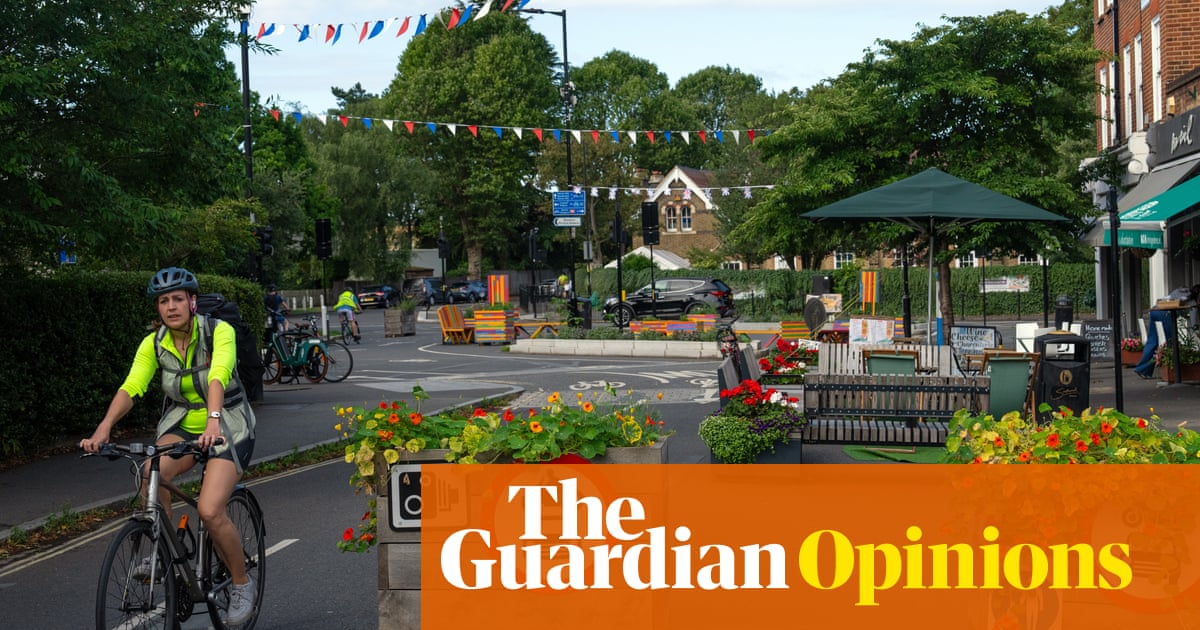Hope springs eternal among those who have long opposed low-traffic-neighbourhood (LTN) anti-pollution schemes after last week’s high court ruling that Lambeth council in south London hadacted unlawfullyin ignoring local objections to its latest scheme. “Low traffic neighbourhoods could be scrapped as campaigners score high court victory – ‘sends a clear signal’”,was the line on GB News. “Low-traffic neighbourhoods could be axed,”said the Express.
But here’s the news: they won’t and it didn’t. Furthermore, to use this specific case to throw out LTNs would be a backwards step for public health, the economy and the climate. So what should happen next? Councils should hold their nerve and trust the data, which shows that LTNs are worth doing, and worth doing well.
Whatever side of the fence you’re on, it’s important to look at the wider body of evidence. And the evidence shows LTNscut traffic,clean the airand enable more walkingand cycling. Crucially, despite the tone of the debates you might be hearing, LTNs are effectiveand popular, and they become more popular over time. The evidence also shows that some councils could do more to have meaningful dialogue with residents, especially those who face thebiggest barriers to their mobility.
Perhaps the biggest criticism of LTNs is that they cause additional chaos and pollution by pushing traffic elsewhere, but this is not what the data shows. The picture derived from studies of actual LTNs in London and around the country is much more nuanced: sometimes traffic in the wider area falls, sometimes it rises, and sometimes it stays the same. Rishi Sunak’s own review of LTNs – conducted at the height of hysteria around the so-called war on the motorist – concluded that effects on boundary roads, whether positive or negative,were minimal.
In my experience, the substance of the backlash against LTNs is often not so much about the LTN itself, but a reaction against unreliable or nonexistent buses, high fares, poor accessibility or overcrowded roads – all of which need fixing, and none of which would be solved by scrapping LTNs. Priority bus lanes, wider pavements, clean air zones, 20mph limits, cycle lanes and phasing out diesel – as well as meaningful engagement with residents – could all help address these concerns, stop traffic or pollution from rising, and give people more choice in how they get around.
When a new LTN comes in, it’s easy to point to it and call it the root cause of congestion, but congestion is nothing new.Londonhas been the most congested city in Europe for years. As obvious as it sounds, the root cause of congestion is that there are simply too many cars on the road.
It’s worth revisiting why modernising our transport network is so important, and why LTNs can help. Air pollution contributes tothousands of premature deaths in our capital each yearand aggravates numerous health conditions,with driving being the single biggest cause. The climate crisis demands at leasta 20% reduction in traffic, with people across the political spectrum supporting urgent action. Meanwhile, fewer than 40% of Londoners are walking or cyclingfor 20 minutes or more each day.
Roughly five peopledie on UK roads every single day, but this fact rarely makes the news. More than 20,000 people areinjured on London’s roads each year, causing untold emotional and physical trauma, and adding to pressures on the NHS and emergency services. The climate charity I work for, Possible,recently estimatedthat these collisions cost London £1.2bn annually. And with cars getting bigger and heavier, and SUVs becoming the norm,the danger to people walking and cycling grows.
Indeed, cutting traffic is extremely popular. Pretty much everyone agrees there should be less traffic – not least to make life easier for those who rely on a vehicle. The evidence suggests that LTNs are a relatively quick and affordable way to do it.
At the heart of all this is a simple fact: the only way to cut traffic – something we all agree would be a good thing – is for some of us to drive a bit less. There is no other magic solution. The myths of freedom for the motorist – painted vividly in advertisements that showLand Rovers cruising through completely empty city centres– must make room for the real-life and realisable freedom of kids to breathe cleaner air in their playgrounds, people to walk and cycle with less risk, and for all of us to get to where we need to go without being stuck in congestion.
Low-traffic neighbourhoods are often framed as inhibiting our ability to get around. But for many of us, they make getting around more possible and desirable – making space for community, for walking, for cycling. No tool or policy is perfect: there are always lessons to learn. But that can’t be an excuse for giving up and doing nothing.
The status quo isn’t working, and in the bigger picture, the evidence base for the effectiveness and popularity of low-traffic neighbourhoods continues to grow. One court case won’t put the brakes on that.
Izzy Romilly is sustainable transport campaign manager at climate charity Possible
